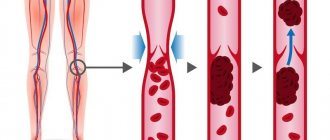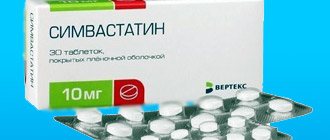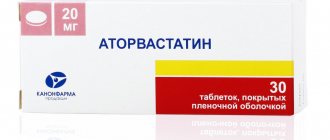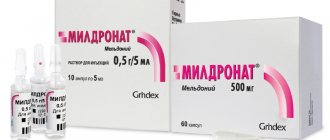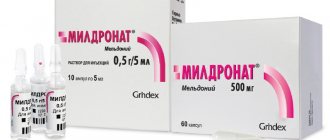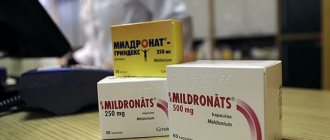Prohibited during pregnancy
Prohibited during breastfeeding
Prohibited for children
Has restrictions for older people
Has limitations for liver problems
Has limitations for kidney problems
Mildronate is a cardioprotective, antihypoxic, angioprotective drug based on meldonium. It is a derivative of gamma-butyrobetaine, that is, it is a synthetic version of B vitamins. It belongs to the medicinal group of metabolic agents. Stimulates the production of kartinin, thereby increasing performance and reducing tissue oxygen demand.
The drug also has the following properties:
- increases the body's endurance to physical activity;
- helps to recover quickly during intense mental work;
- removes toxic metabolic products accumulated in tissues and blocks their further formation;
- promotes cell protection, increases cellular, humoral immunity:
- helps tissues recover more quickly after excessive stress;
- increases the body's endurance in stressful situations;
- restores full blood circulation, which is especially important in case of cerebrovascular accidents;
- speeds up recovery after surgery.
Clinical effectiveness of Mildronate
Basic readings:
- heart failure (HF);
- heart attack;
- acute, chronic pathologies of cerebral circulation;
- dishormonal cardiomyopathy;
- withdrawal syndrome provoked by alcoholism;
- reduced performance.
Mildronate and all similar drugs are contraindicated in children under 18 years of age, women during periods of breastfeeding and pregnancy, as well as with increased ICP. There are many popular and inexpensive analogues of the drug Mildronate, which are worth considering in more detail.
Compound
- One hard gelatin capsule of Mildronate contains 250 or 500 mg of meldonium in the form of dihydrate as an active component and excipients: potato starch, colloidal silicon dioxide, calcium stearate. Gelatin and titanium dioxide are used to make the gelatin shell.
- One Mildronate tablet contains 500 mg of meldonium in the form of phosphate and auxiliary components: mannitol E421, povidone K-29/32, potato starch, silicon dioxide, microcrystalline cellulose, magnesium stearate.
- One milliliter of Mildronate injection solution contains 100 mg of meldonium and water for injection as an auxiliary component.
Release form
The drug Mildronate is produced by the manufacturer in the form:
- clear colorless solution for injection;
- hard gelatin capsules No. 1 and No. 2, filled with hygroscopic white crystalline powder. The powder contained in the capsules has a weak characteristic odor and a sweetish taste (the capsule itself has a neutral taste);
- tablets Mildronate Gx 500 mg (tablet taste slightly sour).
The solution is sold in 5 ml ampoules (500 mg/5 ml). One cardboard package contains: 2 blister packs with 5 ampoules of Mildronate in each and instructions for use of the drug.
Capsules are packaged in blisters of 10 pieces each. One cardboard box contains 4 blisters and instructions for use of the drug.
pharmachologic effect
Meldonium is a synthetic drug that has a similar effect to γ-butyrobetaine (a substance that is a precursor to hydroxytrimethylaminobutyric acid, a natural vitamin-like substance related to B vitamins).
According to Wikipedia, meldonium is characterized by its ability to improve metabolism and energy supply to cells and is used as:
- cardioprotective;
- antihypoxic;
- angioprotective;
- antianginal agent.
The mechanism of action of meldonium determines a wide range of its pharmacotherapeutic properties. Taking this drug helps improve performance, reduces the severity of manifestations of mental, intellectual and physical stress, and activates tissue and humoral immunity.
In patients suffering from heart failure , it increases the strength of contractions of the heart muscle, reduces the frequency of heart attacks ( angina ), and also increases the body's tolerance to physical activity.
In case of acute myocardial damage, the use of meldonium slows down the formation of necrotic zones, shortens the duration of the rehabilitation period, normalizes blood circulation in the area of ischemic damage and redistributes blood in favor of the ischemic area.
Under conditions of increased stress, meldonium helps restore the balance between the transport of oxygen into cells and the cells' need for it, prevents the accumulation of cellular metabolic products and toxic substances in cells, protects cells and cellular structures from damage, ensures rapid compensation by the body of its energy reserves and maintains the highest speed metabolic processes.
By toning the central nervous system, meldonium effectively eliminates disturbances in the functional state of the somatic and autonomic (autonomic) parts of the nervous system, including disorders that accompany withdrawal syndrome in patients suffering from chronic alcoholism .
In addition, the substance has a beneficial effect on the condition of dystrophically altered retinal vessels, which makes it possible to use it for the treatment of vascular and dystrophic pathologies of the fundus.
Mildronate or Cardionate – which is better?
Manufacturer: Nizhpharm, Russia
Release form: capsules, ampoules
Active ingredient: meldonium dihydrate
Synonyms: Mildronate, Idrinol, Meldonium
Cardionate is a domestic analogue and substitute for Mildronate. Capsules are available in a dose of 250 mg of the medicinal substance. The analogue has medicinal properties similar to Mildronate: normalizes blood circulation in the brain, cardioprotective, antianginal, reduces tissue hypoxia, adaptogenic.
Used to treat the following diseases:
- in a complex setting for ischemic heart disease, angina pectoris, heart attack, heart failure, stroke, cerebral circulatory disorders;
- physical and mental fatigue;
- to relieve withdrawal symptoms during long-term alcoholism;
- circulatory disorders and bleeding into the retina.
The dose and method of administration of the analogue are selected by the doctor depending on the stage and nature of the disease.
Which medication is better depends on the individual, since they have the same active ingredient. Mildronate's analogue is cheaper and differs in that it does not have a dosage of 500 mg.
Pharmacodynamics and pharmacokinetics
The action of the active substance of the drug is aimed at inhibiting the enzymatic activity of γ-butyrobetaine hydroxylase, which is the last enzyme in the chain reaction of l-carnitine .
Meldonium helps reduce the concentration of free carnitine , prevents the transport of long-chain fatty acids across cell membranes, and prevents the accumulation in cells of activated forms of unoxidized fatty acids, which are derivatives of acylcarnitine and acyl coenzyme .
In ischemic tissues, it restores the balance between the transport of oxygen and its absorption by cells, prevents disruption of the transport of adenosine triphosphate, while simultaneously activating glycolysis, which occurs without additional oxygen consumption.
The result of a decrease in carnitine concentration is increased synthesis of the vasodilator γ-butyrobetaine.
After taking Mildronate tablets per os, the meldonium it contains is quickly absorbed in the digestive tract. The drug is characterized by a fairly high bioavailability index. The latter is approximately 78%.
The concentration of meldonium in the blood plasma reaches its maximum values an hour or two after administration. In the body, meldonium is metabolized to non-toxic products - glucose, succinate, 3-hydroxypropionic acid.
Metabolites are excreted by the kidneys. The half-life (T½), depending on the characteristics of the particular organism and the dose taken, can range from three to six hours.
The drug in injection form is characterized by 100% bioavailability. The concentration of meldonium in the blood plasma reaches its maximum values immediately after administration of the drug. The half-life (T½), depending on the characteristics of the particular organism and the dose taken, can range from three to six hours.
The result of the metabolization of meldonium is the formation of non-toxic metabolites (glucose, succinate, 3-hydroxypropionic acid), which are then excreted from the body by the kidneys.
Mildronate or Mexidol
Manufacturer: ZiO-Zdorovye, Russia
Release form: tablets, ampoules
Active ingredient: ethylmethylhydroxypyridine succinate
Synonyms: Mexifin, Mexiprim, Neurox, Mexicor
Mildronate substitute in Mexidol tablets has the following properties:
- antioxidant;
- antihypoxic;
- nootropic;
- anxiolytic (reduces feelings of fear);
- membrane-protective;
- anticonvulsant;
- improves metabolic processes and blood circulation in the brain;
- increases the body's resistance to stress and oxygen-dependent factors (ischemia, hypoxia).
Mexidol is used to treat:
- vegetative-vascular dystonia (VSD);
- brain pathologies associated with atherosclerotic changes in blood vessels;
- encephalopathy of various origins;
- neuroses, neurasthenia with anxiety;
- to stop withdrawal symptoms in case of poisoning with antipsychotics;
- acute stage of peritonitis, pancreatitis (not antibiotic) - in a complex treatment regimen;
- uncomplicated traumatic brain injuries and consequences;
- IHD in joint treatment regimens;
- mild cognitive impairment;
- asthenia.
The duration of treatment, depending on the disease, ranges from 1 week to 2 months. Tablets are taken 1-2 pieces 3 times a day.
Compared to Mildronate, the Mexidol analogue still has anti-anxiety properties. Reviews from patients indicate that the drug effectively copes with neurosis-like conditions.
Indications for use of Mildronate
What are Mildronate tablets for and what is the medicine for in the form of injections?
All dosage forms of the drug are intended for the treatment of adult patients.
Indications for use of Mildronate (for all dosage forms of the drug):
- IHD (in combination with other drugs and treatment methods);
- peripheral artery disease;
- reduced performance;
- encephalopathy;
- physical overload (including in sports);
- postoperative period (to speed up the recovery of the body);
- chronic heart failure
- cardialgia (pain in the left side of the chest) caused by dyshormonal myocardiopathy ;
- bronchial asthma;
- COPD;
- alcohol withdrawal (as an addition to specific therapy);
- stroke.
Additional indications for the use of drug injections:
- hemorrhage into the vitreous cavity of the eye ( hemophthalmos );
- hemorrhage in the retina of the eye;
- thrombosis and occlusion of the central retinal vein or its branches;
- retinopathy of various origins (for example, hemorrhagic or diabetic ).
Use of Mildronate in sports
Mildronate is a drug that is characterized by the ability to expand the range of tolerance to physical (both dynamic and static) stress and intellectual function not only in ischemic injuries, but also in healthy people.
The drug is very useful for athletes due to its properties to improve the nutrition of the heart muscle and other muscles of the body and reduce fatigue, while simultaneously increasing the effectiveness of sports training.
Contrary to popular belief, Mildronate is not used as a means to increase muscle mass. Its task in sports and in bodybuilding in particular is somewhat different: Mildronate for athletes is indicated as a prophylactic agent that prevents fatigue (including the heart muscle) and overtraining.
In addition, by promoting faster removal of breakdown products from cells and accelerating the restoration of cellular energy resources, Mildronate improves metabolism at the cellular level and accelerates muscle recovery in athletes after physical activity. Moreover, the latter applies to both strength loads and physical loads on the speed and/or endurance of the body.
There is an opinion that the use of Mildronate in sports can provoke fatty liver hepatosis . However, it is unfounded.
Mildronate prevents fatty acids from penetrating into the cells and thus prevents the accumulation of fats in the liver. In addition, by burning predominantly sugar, the body spends a larger amount of raw materials, which are fats, for each molecule of adenosine triphosphate produced ( that is, for energy production).
Meldonium was not classified as a doping drug until January 1, 2021, which made it possible to use it absolutely legally in all sports.
However, after the introduction of a ban on the use of the drug by the World Anti-Doping Agency (WADA) at the beginning of 2021, a number of athletes, mainly from Russia and the former CIS countries, were caught using this drug. Mildronate also became the subject of a huge scandal when Maria Sharapova admitted using this doping on March 7, 2021.
Do I need an appointment?
Metabolic drugs are one of the components of complex therapy for neurological and cardiovascular diseases (sometimes during the recovery process in oncology, surgery and traumatology). A peculiarity of the use of drugs in this group is a wide range of dose-dependent effects on various organs of the body, therefore a specific amount is selected for each patient in a short course (maximum 6 weeks). Many people are interested in whether it is possible to drink mildronate without a doctor’s prescription. Uncontrolled use of Mildronate is accompanied by the risk of:
Advertising:
- development ari src=”https://karpov-clinic.ru/uploads/postsm/2020-12/1608638208_narushenie-ritma-serdca.jpg” class=”aligncenter” width=”500″ height=”350″[/img]
- formation of cardiomyopathy (due to restructuring of the heart muscle);
- drop in blood pressure;
- violations of the excretory function of the liver and kidneys.
"Mildronate" is used among athletes as a doping to enhance the body's functioning, stimulate activity and increase muscle mass. For the same purpose, steroids are used - artificial hormones of the adrenal cortex, which accelerate the process of weight gain due to muscles (Danabol, Boldabol, Deca, Andropen). Mildronate is a widely prescribed drug in the complex treatment of cardiovascular and neurological pathologies.
The effectiveness of the drug is explained by its effect on metabolism in cardiomyocytes, rehabilitation after “disasters” and prevention of complications. The use of Mildronate by athletes improves endurance and strength, speed of recovery without the side effects characteristic of anabolic steroids. The drug should be used only after consulting a doctor, according to the instructions and dosage regimen.
Side effects
Side effects caused by taking Mildronate occur quite often. Typically they are expressed as:
- allergic reactions (redness, skin rashes, itching and swelling);
- dyspeptic symptoms, manifested by belching, attacks of nausea, vomiting, heartburn, a feeling of fullness in the stomach even after a small portion of food;
- tachycardia;
- increased arousal;
- decrease in blood pressure.
The benefits and harms of the drug
The well-known drug Mildronate, widely used by athletes and older people, was recently added to the anti-doping list of drugs, which caused many scandals in the sports community. How dangerous the drug is, how to use it correctly, as well as the harm and benefits of mildronate for the body - those who have been prescribed this medication should know about all this. The product is available in the form of capsules, liquid for injection, and also in solid dosage form.
The main component is meldonium, a compound found in the cellular structures of the human body. Let's take a closer look at the benefits and harms mildronate brings to the human body. The drug promotes the onset of complex chemical processes in the body and acts as follows:
- increases the body's endurance, increases performance;
- has a positive effect on the state of tissue immunity;
- promotes mental and physical stability under severe stress;
- reduces the load on the heart.
Thus, the effect of mildronate on the body is predominantly positive. The medicine quickly delivers oxygen to cells and tissues, cleanses organs of toxins and metabolic products, and also protects them from destruction. After using mildronate, the following negative consequences have been established:
Advertising:
- allergic skin rashes, swelling. Most often observed with intramuscular use of the drug;
- dyspepsia, heaviness in the abdomen, vomiting, nausea, heartburn;
- increased heart rate, which manifests itself during emotional arousal;
- decrease in blood pressure readings.
To avoid overdose and other negative consequences, when purchasing a product you should pay attention to the dosage: the drug is available in 250 and 500 mg doses.
Instructions for use of Mildronate
You can often come across questions “.. can Mildronate be administered intramuscularly?” or “.. is it possible to inject the drug intramuscularly?”
The instructions for medical use indicate that the drug in injection form is intended for intravenous administration, and capsules and tablets are intended for oral administration (per os).
Dosage forms for oral administration should be taken whole, without chewing, crushing or pouring out the contents of the capsules.
Mildronate for intravenous administration is produced in finished form. Mildronate should be administered intravenously separately from other drugs; dilution with an aqueous solution of sodium chloride is not required (however, in some cases it is allowed).
When injected into a muscle, the injection solution has an irritating effect and can provoke local pain and local allergic reactions. For this reason, the drug Mildronate is usually injected into a vein.
Mildronate injections: instructions for use, why they are prescribed and how to dose the injection solution
Indications for the use of Mildronate injections: unstable (progressive) angina pectoris , myocardial infarction , vascular pathologies of the fundus and cerebral circulatory disorders.
For patients with coronary syndrome, the drug is administered into a vein as a bolus at a dose of 500-1000 mg once a day. After this, therapy is continued by taking tablets or capsules.
For patients with vascular pathologies of the fundus of the eye, the medicine is administered retrobulbarly (behind the eyeball) or subconjunctivally (under the outer shell of the eyeball) 0.5 ml for 10 days.
For patients with cerebral circulatory disorders in the acute stage, the solution is administered into a vein once a day at a dose of 500 mg. The duration of the therapeutic course is 10 days. Further treatment is carried out using oral dosage forms.
Patients with chronic cerebral circulatory disorders are advised to administer Mildronate intramuscularly one to three times a day at a dose of 500 mg (optimally before lunch). The duration of the therapeutic course is from 2 to 3 weeks.
Mildronate tablets: instructions for use
For patients with diseases of the cardiovascular system, Mildronate tablets and capsules are indicated in combination with specific therapy. The drug is taken at 500-1000 mg per day. The entire dose can be taken either at once or divided into two doses.
As a rule, the course of treatment lasts from 4 to 6 weeks.
For cardialgia caused by dishormonal myocardiopathy , Mildronate is taken once a day, one 500 mg tablet or 2 250 mg tablets.
For patients with cerebral circulatory disorders, after eliminating acute disorders, the drug is recommended to be used at a dose of 500-1000 mg per day. Take it in one dose or divided into two doses.
Patients with chronic cerebral circulatory disorders are recommended to take 500 mg of Mildronate per day.
The duration of treatment varies from 4 to 6 weeks. At the discretion of the attending physician, the patient may be prescribed repeated courses of treatment (usually two or three times a year).
Patients with pathologies of peripheral arteries are prescribed to take the drug twice a day, 500 mg. The recommended dose for increased intellectual and physical stress on the body (including athletes) is 1000 mg, which should be divided into two doses.
The duration of treatment is from 10 to 14 days. If necessary, the course is repeated after a two- or three-week interval.
In the period before training, athletes are recommended to take Mildronate twice a day at a dose of 500-1000 mg. The duration of treatment in the preparatory period is usually from two to three weeks; during the competition period its duration varies from 10 to 14 days.
For alcohol withdrawal , patients suffering from chronic alcoholism should take Mildronate 500 mg four times a day. The duration of the course is from 7 to 10 days.
The maximum permissible daily dose is considered to be 2000 mg.
Mildronate or Enerion - which is better?
Manufacturer: Servier, France
Release form: tablets
Active ingredient: sulbutiamine
Enerion is an imported analogue of Mildronate in tablets. It is produced in one therapeutic dosage, the price depends on the amount of medication in the package - 20 or 60 tablets.
The active substance of the analogue is synthetic, similar in structure to vitamin B1. Thanks to the modified formula, it is well absorbed by the body.
While taking the analogue, coordination of movements is normalized, endurance of physical activity increases, and the resistance of the cerebral cortex to hypoxia increases. The Mildronate analogue has proven itself effectively in the symptomatic treatment of functional asthenia.
Enerion is approved for use only by adults. The dose is taken 2 times per day in the morning and lunchtime. The duration of therapy with the analogue should not exceed a month.
It is difficult to select the best drug, since they differ in composition, and the analogue is used to treat one disorder. You should rely on the symptoms of the disease and select the appropriate medication.
Interaction
Combination of Mildronate with antianginal, antiarrhythmic, anticoagulant, antiplatelet and diuretic drugs, cardiac glycosides, bronchodilators and other drugs is allowed.
Mildronate has the ability to potentiate the effect of Nitroglycerin and β-adrenergic blockers, Nifedipine and other drugs with coronary action, antihypertensive drugs, as well as drugs whose action is aimed at dilating peripheral blood vessels.
Due to the possible development of moderate tachycardia and a decrease in blood pressure, the above drugs should be used in combination with Mildronate with caution.
special instructions
Due to the fact that the drug can provoke a stimulating effect, it is recommended to use it in the first half of the day.
There are no data regarding the ability of Mildronate to change the reaction rate and influence transport control.
The drug is prescribed with caution to people with liver and/or kidney pathologies.
Experience in treating patients with myocardial infarction and unstable angina shows that the active substance Mildronate is not a first-line drug for ACS.
Briefly about the drug
Under conditions of increased stress, Mildronate restores the balance between the supply and need of cells for oxygen, eliminates the accumulation of toxic metabolic products in cells, protecting them from damage; has a tonic effect. As a result of its use, the body acquires the ability to withstand stress and quickly restore energy reserves. Thanks to these properties, Mildronate is used to treat various disorders of the cardiovascular system, blood supply to the brain, as well as to increase physical and mental performance.
Analogues of Mildronate
Level 4 ATX code matches:
Vazonat
Phosphaden
Hawthorn fruit
Preductal
Meldonium
Angiosil Retard
Ranexa
Lily of the valley tincture
Neocardil
Rimecore
Triductane
ATF-Long
Hawthorn tincture
Triductan MV
Trimectal MV
Trimectal
Neoton
Predisin
Trimetazidine
Tivortin Aspartate
Analogues of Mildronate:
- Vasopro
- Vazonat
- Metamax
- Methonate
- Trizipin
- Mildracore
- Mildrocard
- Cardionate
- Melfort
- Idrinol
- Riboxil
- Meldonium
The price of drug analogues starts from 170 rubles.
Riboxin or Mildronate - which is better?
Riboxin is a natural compound found also in the human body.
Being a precursor of adenosine triphosphate , it helps to increase the energy balance of the heart muscle, improve coronary circulation, reduce the severity of the consequences of intraoperative ischemic kidney damage, stimulate the production of nucleotides and the activity of individual enzymes of the citrate cycle.
The drug has a positive effect on metabolic processes in the heart muscle, increases the force of its contractions and stimulates its more complete relaxation in diastole, which in turn leads to an increase in stroke volume (stroke volume of blood).
Mildronate has a similar effect, but is not itself involved in the synthesis of other substances. At the same time, the drug regulates the activity and biosynthesis of enzymes involved in energy production, and thus normalizes metabolism.
The conclusion is this: Mildronate is a drug whose action is aimed at correcting metabolic processes, while Riboxin takes part in biochemical reactions and is a means of metabolic action.
To obtain the expected effect from the use of Riboxin, it should be administered in quantities that are comparable to its consumption in the body. And since Riboxin is used by the body in various reactions, it is required in very large quantities.
Mildronate, on the contrary, is not consumed in metabolic reactions, its effect lasts for a longer period of time, and its body requires much less than Riboxin.
Therefore, the use of Mildronate also improves the body’s use of Riboxin. Thus, the combined use of these drugs will potentiate each other's effects.
Cardionate or Mildronate - which is better?
Cardionate and Mildronate are synonymous drugs. They are based on the same active ingredient, so both products have a similar mechanism of action.
The only difference is that, unlike Mildronate, Cardionate is available only in the form of 250 mg capsules and 500 mg/5 ml injection solution.
Mildronate or Idrinol
Manufacturer: Sotex, Russia
Release form: capsules, ampoules
Active ingredient: meldonium dihydrate
Synonyms: Mildronate, Cardionate, Meldonium
The Russian analogue Idrinol consists of the same active ingredient as Mildronate - meldonium. It has identical pharmacological actions and indications for use. An analogue of Mildronate is produced in ampoules and capsules in a dosage of 250 mg.
According to reviews from doctors and patients who took the analogue, it is not inferior in effectiveness to the therapy of the original medication. It has a more affordable price, which allows it to be used by different segments of the population.
Alcohol compatibility
The active substance of Mildronate is excreted from the body within 12 hours, therefore, after this time, the risk of interaction of the drug with another active substance is extremely low or completely absent.
In general, drinking alcohol during treatment with Mildronate is not prohibited; however, if this drug is used to treat a cardiovascular disease or a cerebral circulatory disorder, the patient is still advised to stop drinking alcohol.
This is due to the fact that taking the drug in combination with alcohol can negate all the positive results that have been achieved in treating the disease.
Taking Mildronate with alcohol can provoke:
- tachycardia;
- pronounced allergic reactions ;
- sharp fluctuations in blood pressure;
- dyspeptic symptoms.
The poor compatibility of Mildronate with alcohol is due to an increased risk of various types of complications and the likelihood of a relapse of the disease. For this reason, alcohol should be excluded for the entire period of treatment with the drug.
Prices for the drug and its main analogues, average in Russia
In a situation where Mildronate is not suitable, available analogues of the drug (generics or substitutes) are selected. The most popular and cheapest of them are presented in the table. They can be used when the main drug is unaffordable or has other restrictions. The selection of a specific medicine is carried out by the doctor, taking into account the diagnosis, concomitant diseases, and possible contraindications.
| A drug | price, rub. |
| Mildronate | 450-500 |
| Vazonat | 160-230 |
| Idrinol | 120-150 |
| Cardionate | 170-200 |
| Meldonium | 200-220 |
| Melfort | 180-200 |
| Riboxin | 80-120 |
| Preductal | 780-1370 |
Use of Mildronate during pregnancy and lactation
The safety of Mildronate for the treatment of pregnant women has not been proven. To exclude the possibility of its adverse effects on fetal development, the drug is not prescribed during pregnancy .
It has not been established whether meldonium can be excreted in the milk of a nursing woman. Therefore, if treatment with Mildronate is indicated for the mother, she must stop breastfeeding .
Parabulbar administration of mildronate
In ophthalmology, this type of injection is performed as parabulbar injection; what this procedure is and how it is carried out is difficult for the uninitiated to understand. Let's take a closer look at what parabulbar administration of mildronate is and how it happens.
This is an injection given by a highly qualified doctor into the lower eyelid under the eye. In this way, an anesthetic or other drug that acts on the organ of vision or the entire body is delivered in ophthalmology.
Performed during operations or therapy.
The peculiarities of the administration are highlighted, since complications sometimes arise due to pain. The purpose of the injections is to restore the body’s functioning, restore energy, and deliver medicine to the eye. Parabulbar injections are a painful process in which the doctor inserts a needle into the lower eyelid to a depth of 1 cm into the eye tissue. The risk of injuring the eyeball is high, so the needle with the drug is administered only by knowledgeable ophthalmologists of the highest category and when absolutely necessary.
Subconjunctival and parabulbar injections are indicated for the treatment of diseases and injuries of the anterior part of the eye:
- sclerites;
- keratitis;
- iridocyclitis.
Retrobulbar injections are prescribed for pathology of the posterior region:
- chorioretinitis;
- neuritis;
- hemophthalmos.
Parabulbar administration is determined when surgical intervention by a doctor in the eye area is required. Anesthesia is injected into the fiber, the medicine reduces the susceptibility of nerve endings. Basically, the solution for the procedure contains lidocaine 0.5% and hyaluronidase.
Advertising:
Reviews of Mildronate
Reviews about Mildronate on forums are mostly positive . The unique mechanism of action of this drug allows it to be widely used to eliminate problems with the cardiovascular system, as well as as a means of increasing performance in healthy people who are subject to frequent physical and intellectual overload.
Both patients in cardiology departments, doctors, and athletes note the fact that Mildronate provokes a tonic effect. Its use significantly improves memory function, accelerates thought processes, increases dexterity, endurance and the degree of body resistance to adverse factors.
Reviews from cardiologists confirm the data of numerous studies that have shown that the use of Mildronate in capsules and in the form of a solution for injections can reduce the incidence of repeated myocardial infarction .
Reviews from patients about Mildronate allow us to conclude that the drug is simply necessary for people whose activities are associated with increased stress on the body, as well as during the recovery period after prolonged alcohol abuse, with pain and burning in the heart, VSD and other pathologies of the cardiovascular system .
The average rating for this product is quite high. However, sometimes you come across negative reviews about Mildronate. It is important to remember that, like any other drug, Mildronate gives a good result only if its dose and concomitant treatment (if necessary) are selected correctly.
Mildronate or Riboxin - which is better for the heart
Manufacturer: Biosintez, Russia
Release form: tablets, ampoules
Active ingredient: inosine
Riboxin is a cheap analogue of Mildronate in tablets, produced in Russia. The composition is different, but the pharmacological effect is similar: it normalizes the processes of oxygen and glucose metabolism in body tissues, reduces hypoxia, reduces cardiac arrhythmia, normalizes coronary circulation, and stimulates the regeneration of myocardial tissue.
The Riboxin analogue is used to treat:
- IHD, heart defects, dystrophic changes in the myocardium, after a heart attack - in complex therapy;
- liver diseases: cirrhosis, hepatitis, fatty degeneration;
- prevention of leukopenia after radiation exposure;
- during surgery on an isolated kidney as pharmaceutical protection.
The drug is not used in acute cases of cardiac muscle dysfunction. The analogue is used to maintain the myocardium and prevent the development of emergency pathological conditions. In sports, Riboxin is also used to improve metabolic processes and endurance of the body.
Tablets are taken before meals for 1–3 months.
Both drugs are used for diseases of the cardiovascular system; which drug is better in each case, you should consult a doctor, as they have contraindications.
Mildronate price
Price of the drug in Russia
You can buy 250 mg capsules in Russian pharmacies for an average of 300 rubles, 500 mg capsules for 650 rubles. The price of Mildronate for intravenous administration is 350 rubles. Price Mildronate Gx 500 mg - about 800 rubles.
Price of the drug on the Ukrainian market
The average price of Mildronate 250 mg tablets is 250 UAH. The price of Mildronate ampoules of 5 ml is 450 UAH. 500 mg capsules cost about 400 UAH per package. Mildronate GX is sold for an average of 450 UAH.
Moreover, Mildronate injections, tablets and capsules in pharmacies in Kharkov or Odessa are somewhat cheaper than in most pharmacies in the capital.
- Online pharmacies in RussiaRussia
- Online pharmacies in UkraineUkraine
- Online pharmacies in KazakhstanKazakhstan
ZdravCity
- Mildronate caps.
500 mg 60 pcs. JSC Grindeks 558 rub. order - Mildronate caps. 250 mg 40 pcs. JSC Grindeks
RUB 254 order
- Mildronate solution IV, IM and parabulb. input 100 mg/ml amp. 5ml No. 10HB Pharma s.r.o.
RUR 348 order
- Mildronate sol. IV and parabulb. input 100 mg/ml amp. 5 ml 10 pcs. HB Pharma s.r.o.
RUB 356 order
- Mildronate solution for IM, IV and parabulb. input 0.1g/ml 5ml 20pcsHB Em Pharma s.r.o.
675 rub. order
Pharmacy Dialogue
- Mildronate 10% ampoules 5ml No. 10Grindex/HM Pharma
RUB 337 order
- Mildronate capsules 500 mg No. 60Grindex
RUR 527 order
- Mildronate capsules 250 mg No. 40Grindex
RUB 232 order
- Mildronate (amp. 10% 5ml No. 10) Sanitas
RUB 337 order
- Mildronate 10% ampoules 5ml No. 10Santonica JSC
340 rub. order
show more
Pharmacy24
- Mildronate 0.5 g/5 ml 5 ml No. 10 solution AT "Grindeks", Latvia
830 UAH. order - Mildronate 500 mg N60 capsules AT "Grindeks", Latvia
409 UAH order
- Mildronate GX 500 mg N60 tablets AT Grindeks, Latvia
442 UAH order
- Mildronate 5 ml N10 solution AT "Grindeks", Latvia/HBM Pharma s.r.o., Slovakina
461 UAH order
PaniPharmacy
- Mildronate capsule Mildronate caps. 0.25g No. 40 Latvia, Grindeks
251 UAH order
- Mildronate GX tablets Mildronate GX tablets 0.5g No. 60 Latvia, Grindeks
487 UAH. order
- Mildronate ampoule Mildronate solution d/in. 10% amp. 5ml No. 10 Lithuania, Sanitas
450 UAH. order
- Mildronate solution d/in.amp.0.5g/5ml 5ml N20
901 UAH. order
- Mildronate capsule Mildronate caps. 0.5g No. 60 Latvia, Grindeks
412 UAH. order
show more
